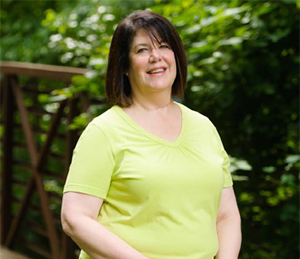Joy's Story
Advanced Back and Neck Surgeries Relieve a Lifetime of Suffering

If I had known before what I know now, I would have done the surgeries much sooner."
-Joy Lazaroff
After four decades of pain, Joy Lazaroff finally had had enough. Joy, now 54, had injured her back when she was 14 years old. Then, six years later, a car accident fractured vertebrae in her neck. Over time, her conditions got worse, to the point where the pain would leave her bedridden for weeks.
Joy had tried conservative treatment — such as medication and physical therapy, but without success. She knew that she would have to have two surgeries someday—one to repair her back and a separate one to repair her neck—but she was scared.
“I put it off for over 20 years,” Joy says. “Finally, when I couldn’t get off the couch or stand up straight any more, I was ready to consider back surgery.”
Joy’s reluctance was understandable. She had heard for years that back surgery didn’t work—or made the problem worse.
Advanced Treatment Options
Philip Schneider, MD, orthopedic spine surgeon and medical director of the Holy Cross Hospital Spine Center, has heard many similar stories.
“I mostly see people who have had problems for a long time,” Dr. Schneider says. “When I saw Joy, she had tried everything and there was really no other option except surgery. I told her ‘If you’re ready, we can fix it.’ Nowadays, back and neck surgeries have a very high success rate.”
An expert in minimally invasive spinal surgery, Dr. Schneider trains physicians from around the world in cutting-edge spinal surgery through the GATE Institute at Holy Cross Hospital, a training center for physicians who perform minimally invasive procedures.
For Joy’s back surgery, Dr. Schneider teamed with Frederic Schwartz, MD, neurosurgeon, Holy Cross Hospital. Joy had spinal stenosis, a narrowing of the opening of the spine, which causes nerves to be crimped. Dr. Schwartz opened up the spinal canal to relieve pressure on the nerves.
Joy also had an unstable spine because her bones were misaligned. Dr. Schneider performed a spinal fusion using the least invasive approach available, placing rods and screws to stabilize and strengthen her spine. This resulted in a faster recovery because there is less blood loss and smaller incisions. Joy was only in the hospital for two days.
From the time she arrived at the Holy Cross Hospital Spine and Joint Centers, Joy noticed a dramatic difference from previous stays at other hospitals.
“I had a private room that was not just comfortable for me, but also for my visitors,” she says. “Plus, there were no restrictions on visiting hours. Room service brought meals when I wanted them. And the laminate wood floors made it easy to walk with a walker.”
The nursing staff in the Spine Center are specially trained to take care of patients with spine surgery and the Center enjoys very high patient satisfaction rates.
Within just four weeks after surgery, Joy was walking tall and straight. In eight weeks, she was back at work, and after 12 weeks, she resumed her fitness walking regimen.
Minimally Invasive Neck Surgery
Joy’s back surgery went so well that she felt comfortable talking to Dr. Schneider about her neck pain. She was losing feeling in one hand and could barely turn her head. An MRI showed herniated disks in her neck.
At first, Dr. Schneider tried nonsurgical treatments, but her pain was becoming more severe. A second MRI confirmed that her condition was clearly getting worse, and Dr. Schneider recommended proceeding with surgery.
Using minimally invasive techniques, Dr. Schneider fused three disks and inserted a metal plate and screws in her neck.
“This was all done through a very small incision in the front of the neck, which means less pain and no bleeding,” he says. “Joy was able to turn her head immediately after surgery.”
Joy’s neck surgery required just a single night in the hospital. Today, for the first time since she was a teenager, she’s essentially pain-free.
“Two years ago, I couldn’t stand up straight. I can’t believe I’m the same person,” says Joy. “Dr. Schneider changed my life.”
